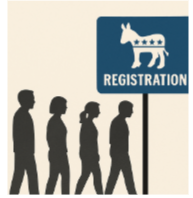Patrick Ruffini argues Democrats’ collapsing approval ratings aren’t proof of a GOP surge.
What to Know:
- Democrats’ favorability dropped to -30 in July’s Wall Street Journal poll, lower than Republicans at -11.
- Disillusioned voters are not joining Republicans, they are souring on politics itself.
- Biden remains the party’s face, keeping Democrats tied to his low approval.
- Economic wins have not translated into voter confidence.
- The risk in 2026 is not Republican strength but Democratic apathy.
For the first time in recent memory, Democrats are staring at numbers that used to be the GOP’s burden: net favorability ratings that make them look like the unpopular party. A Wall Street Journal poll conducted in late July revealed a net favorability rating of -30 for Democrats, significantly lower than Republicans' -11. This appears catastrophic, suggesting a mass exodus from the Democratic party.
Screenshot from Patrick Ruffini’s website
But GOP pollster Patrick Ruffini warns against taking those top-line numbers too literally. In a recent podcast interview and newsletter, Ruffini unpacks what’s really driving the collapse. His thesis: this isn’t about Trump’s comeback. It’s about Democrats’ failure to adapt to a political environment defined by collapsing institutional trust, Biden’s overexposure, and an inability to message around real but underappreciated economic wins.
It’s Not Trump, It’s the System
Ruffini argues that Democrats are misreading the story. These aren't new GOP supporters. Instead, these voters, who once viewed Democrats as responsible leaders, are now abandoning the political system entirely, grouping Democrats with other failing Washington institutions.
“The voters who are newly disillusioned with Democrats still hate Republicans,” he notes.
The decline tracks with broader trust indicators: faith in Congress, the media, and universities have all cratered over the last decade. Ruffini suggests that the Democratic party's strong association with various institutions led to a decline in their public image when trust in those institutions eroded.
Biden Fatigue
Another layer: President Biden’s overexposure. Ruffini points out that Biden, unlike past presidents, has remained the omnipresent face of the party even in his lame-duck years. Historically, second-term presidents recede from the stage, giving space for the next generation.
Image generated by DALL-E
Democrats are more closely linked to an unpopular leader than Republicans are to Trump, largely due to Biden's refusal to step down despite his consistently low approval ratings. This creates a paradox. Trump remains deeply disliked, but he’s no longer the central focus of American politics. Biden still is, and Democrats are paying the price.
The Messaging Failure
Perhaps the most stinging part of Ruffini’s analysis is his take on Democratic messaging. The Biden administration has overseen steady job growth, declining inflation, and a booming stock market. Yet Ruffini argues Democrats have failed to connect those wins to voters’ lived experience.
“The economy is doing better, but voters don’t feel better,” Ruffini explains.
That disconnect was clear in swing-state polling last cycle: in Michigan and Pennsylvania, Independents were 18–25 points more likely to back Harris when she emphasized the economy: but she rarely did. Trump, meanwhile, hammered relentlessly on prices and jobs, cementing himself as the candidate who talked about what people cared about most.
A Warning for 2026
So what does this mean for the midterms? Ruffini’s bottom line: don’t mistake cratering Democratic approval for a GOP wave in waiting. Instead, it’s a sign that Democrats have lost their monopoly on institutional trust and haven’t figured out how to compensate.
Ruffini puts it bluntly: “When people stop believing the system works, the party most identified with the system suffers.”
That leaves them vulnerable to turnout collapse among their own base, particularly younger voters and communities of color who already showed signs of disengagement in 2024.
Lessons from Past Midterms
History backs him up. In 2010 and 2014, Democrats misread warning signs and assumed GOP unpopularity would save them. Instead, low enthusiasm among their own voters handed Republicans wave elections. In 2018, the reverse happened: Democrats capitalized on anti-Trump intensity to drive midterm turnout. The 2026 midterm elections may mirror 2010: the incumbent party could face losses not because the opposition gains favor, but due to their own voters' apathy.
Wrap Up
Ruffini’s analysis should jolt Democratic strategists out of complacency. Democrats are increasingly viewed as synonymous with institutions that Americans distrust, rather than Donald Trump's sudden surge in popularity. Unless they pivot hard on economic messaging, recalibrate their brand beyond Biden, and rebuild enthusiasm among disillusioned blocs, 2026 could bring another punishing midterm map. The ground is shifting. Democrats don’t see it clearly yet. According to Ruffini, the Democrats' blind spots are more responsible for their declining approval than Trump's strength.





